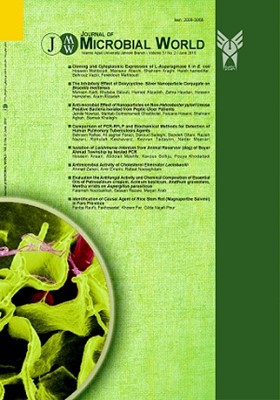Identification of causal agent of rice stem rot (Magnaporthe salvinii) in Fars province
Subject Areas : MycologyFariba Raufii 1 , Fakhrosadat Khosro Far 2 , Gilda Najafi Pour 3
1 - Department of Plant Pathology, Jahrom Branch, Islamic Azad University, Jahrom, Iran
2 - Plant Protection Management Organization, Shiraz, Iran
3 - Department of Plant Pathology, Jahrom Branch, Islamic Azad University, Jahrom, Iran
Keywords: Magnaporthe salvinii, Rot, Rice foot,
Abstract :
Background and Objective: Stem rot disease caused by Magnaporthe salvinii is one of the most common limiting factors for rice production. It was first reported from Italy and in a short time from all over the world. Although rice stem rot in tillering stage was identified widely in different area of Fars province, no causal agents had been detected before the study. The aim of this study was to evaluate the causal agent of rice foot rot specially Magnaporthe salvinii in Fars province. Materials and methods: During 2008-2009, foot and root rotted rice samples were collected from infected fields in Fars province. After purification of the Samples and their cultivation in selective media, the produced fungal sexual forms were characterized. In the next step, all of the isolates were tested for pathogenicity. Results: The cultured isolates first produced white colonies in culture media, but their color changed to gray after few days. Based on our results, the asexual and sexual forms were diagnosed as Nakataea sigmoidea and Magnaporthe salvinii, respectively. Pathogenicity tests showed that the isolate is very virulent and It can make injuries in the susceptible hosts. Conclusion: The result obtained from this study showed that rice foot and root rot caused by Magnaporthe salvinii is very dispersed in various aria of Fars province. This is the first report of Magnaporthe salvinii in Fars province.
1. Cintas NA, Webster RK. Effects of rice straw management on Sclerotium oryza inoculum, stem rot severity, and yield of rice in California. Plant Disease. 2001; 85(11): 1140-1144.
2. Krause RA, Webster RK. The morphology, taxonomy, and sexuality of the rice stem rot fungus, Magnaporthe salvinii (Leptosphaeria salvinii). Mycologia. 1972; 64(1): 103-114.
3. Von Arx JA, Muller, E. Die Cattangen der amersoporen Pyrenomycetes. Beiter Kryptogamenflora Schweiz. 1954; 11(1): 434P.
4. Tsuda M, Ueyama A. Formation of ascigerous stage of Magnaporthe salvinii in culture by the crossing of Japanese isolates. Trans Mycol Soc Jpn. 1978; 19: 425-431.
5. Konthoujam J, Chhetry GKN. Production of sclerotia by Sclerotium oryzae and incidence and susceptibility of rice cultivars under field conditions. J Mycopathol Res. 2006; 44(1): 85-89.
6. Krause RA, Webster RK. Stem rot of rice in California. Phytopathology. 1973; 63: 518-523.
7. Javan-Nikkhah, M. Ethiology of rice stem rot in Guilan. MSc Thesis, University of Tehran, College of Agriculture, Karaj, Iran. 1995; 133P. [in Persian].
8. Behrozin M, Assadi P. Report on important diseases of rice in East Azerbaijan provice. Proceedings of 1th Crop Science Congress Iran. 1994; P.109. [ in Persian].
9. Thongkantha S, Jeewon R, Vijaykrishna D, Lumyong S, Mckenzie EHC, Hyde KD. Molecular phylogeny of Magnapordaceae (Sordariomycetes) with a new species, Ophioceras chiangdaoense from Dracaena loureiroi in Thailand. Fungal Divers. 2009; 34: 157-173.
10. Hanlin RT. Illustrated genera of ascomycetes. American Phytopathological Society Press, St. Paul, Minnesota. 1997; 2097P.
11. Moldenhauer KAK, Lee FN, Bernhardt JL, Norman RJ, Slaton NA, Wilson CE, Anders MM, Cartwright RD, Blocker MM. Registration of Wells rice. Crop Sci. 2007; 47: 442-443.
12. Tucker SL, Besi M, Galhano R, Franceschetti M, Goetz S, Lenhert S, Osbourn A, Sesma A. Common genetic pathways regulate organ-specific infective behaviour in the rice blast fungus. The Plant Cell. 2010; 22(3): 953-972.
13. Besi M, Tucker SL, Sesma A. Magnaporthe and its relatives. In: Encyclopedia Life Sciences. John Wiley & Sons, Ltd: Chichester. 2008.
14. Reis EM, Wordell- Fiho JA. Previsᾶo de doenḉas de plantas. In: Reis EM. Previsᾶo de doenḉas de plantas Passo Funo: UPF. 2004; 316P.
15. Tusda M, Waki T, Ueyama A. Ascocarp production of Magnaporthe salvinii in culture. T Brit Mycol Soc. 1982; 78(3): 515-519.
16. Yaegashi H. Inheritance of pathogenicty in crosses of Pyricularia isolates from weeping lovegrass and finger millet. Ann Phythopathol Soc Jpn. 1978; 44: 626-632.
17. Barr ME. Magnaporthe, Telihmenella, and Hyponectria (physosporellaceae). Mycologia. 1977; 69(5): 952-966.
18. Herbert TT. The perfect stage of Pyricularia grisea. Phytopathology. 1971; 61: 83-87.
19. Piotti E, Rigano MM, Rodino D, Rodolfi M, Castiglione S, Picco AM, Sala F. Genetic structure of Pyricularia grisea (Cooke) Sacc. Isolates from Italian paddy fields. J Phytopathol. 2005; 153(2): 80-86.


